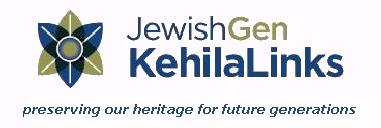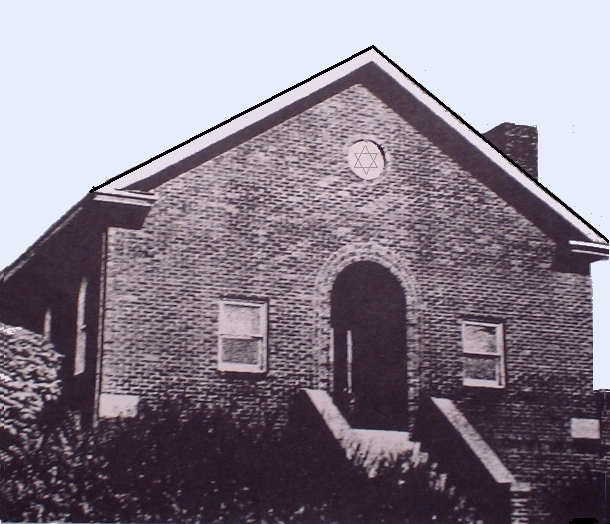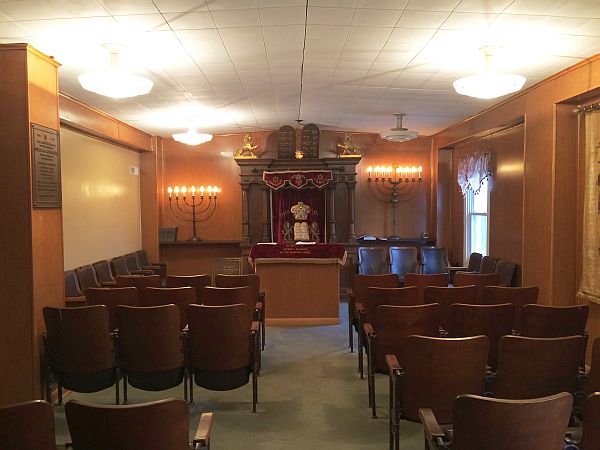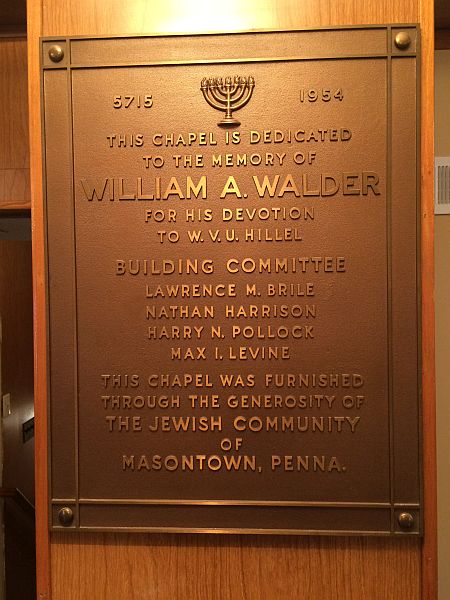Beth El Synagogue
Dedicated: 13 Sep 1925
Photo: Masontown Public Library via
Rauh Jewish Archives at the Heinz History Center
Image enhanced by Marshall Katz
(Click the image below to view a larger image.)
|
|
|
The procession to the synagogue bearing the Torah (Old Testiment) marched from the residence of Louis FRANKLIN, through Main and Church streets, to the synagogue on Neff Avenue. The procession included Rabbi H. J. STERN from Uniontown, Pa. and Rev. KREINES of Connellsville, Pa., the instructors of Hebrew school and the members of the congregation. Participating in the dedication ceremony were Rev. KREINES, Edith HIESCH, Sara EPSTEIN, Hymen BUSH, Benjamin WOLKOFF, M. PEARL, Mrs. William BUSH and Rabbi STERN.
The synagogue was a beautiful two-story red brick building building, containing a large area for a cheder (religious school) on the first floor, which was used for meeting and banquet purposes.
On the second floor, the main sanctuary— with 165 seats, all upholstered in leather—and a beautiful Ark of real craftsmanship. The woodwork was finished in Early English. Also, there was a Kosher kitchen and large restrooms.
The entire enterprise had been the combined effort of the 24 Jewish families residing in Masontown, who were desirous of their own synagogue for worship. The officers of the building committee were M. PEARL (chairman), E. MARGOLIS, M. MARGOLIS, W. BUSH, N. JANOFF and B. FRANKLIN.
In 1925, the officers of the Beth El congregation were Ben WOLKOFF (President), L. FRANKLIN (Vice-president), T. J. PINSKER (Secretary), W. BUSH (Treasurer) and Jack HIRSCH (chairman).
Once the synagogue closed, the Hillel at the West Virginia University, Morgantown, W.Va. acquired the interior furnishings, Ark and Torahs, from the Beth El congregation in Masontown and they were installed on the third floor of the three-floor Hillel facility at the university, and thus became the chapel.
The synagogue was first sold to the Boy Scouts for one dollar who used it for their activities, then after it laid vacant, no longer in use, the local community decided the building would be perfect to house a library. They embarked to secure the necessary funds and today, the building houses the Public Library. |
|
former Beth El Synagogue
Photo: flicker
today, the Public Library
(Click the image below to view a larger image.)
|
|
|
~ Beth El Synagogue Furnishings ~
|
When the Beth El synagogue closed, the religious and other furnishings of the synagogue were donated by the Jewish Community of Masontown to the Hillel at West Virginia University, in nearby Morgantown, W. Va.
The Chapel in Hillel was dedicated to the memory of William A. WALDER, for his devotion to WVU Hillel.
|
|
[ click image to enlarge it. ]
|
WVU Hillel Chapel I
2015
Photo: Deva SOLOMON and Hillel of West Virginia University
|
|
WVU Hillel Chapel II
2015
Photo: Deva SOLOMON and Hillel of West Virginia University
|
|
WVU Hillel Chapel III
2015
Photo: Deva SOLOMON and Hillel of West Virginia University
|
|
|
|
Mother's Club
|
In 1922, the women organized a Mother's Club in service to the Jewish community. The officers of the club were Mrs. J. HIRSCH (President), Mrs. S. ROSENHEIN (Vice-presidents), Mrs. T. PINSKER (Secretary) and Mrs. H. KAPLAN (Treasurer).
To accomplish their splendid work, the auxiliary sponsored card parties, dinner dances, etc. to raise money for the synagogue and the less fortunate.
|
|
Ladies Auxiliary
|
In 1926, the women being very interested in service to the Jewish community, organized a Ladies Auxiliary. The officers of the auxiliary were Mrs. S. ROSENSHEIN (President), Mrs. William HERTZBERG (Vice-presidents), Mrs. S. ROSENFELD (Secretary) and Mrs. H VOGEL (Treasurer).
To accomplish their splendid work, the auxiliary sponsored card parties, dinner dances, etc. to raise money for the synagogue and the less fortunate.
|
|
~ Summary ~
|
This small but enterprising Jewish community participated with their coreligionists in neighboring towns by supporting their worthy causes, and they contributed to the values in advancing the cause of Jews and Judaism. They supported other worthy projects, Jewish and non-Jewish, along side their Masontontown brethren. The Jewish community of Masontown was commended for their progress developing the right kind of Jewish community.
|
| |






